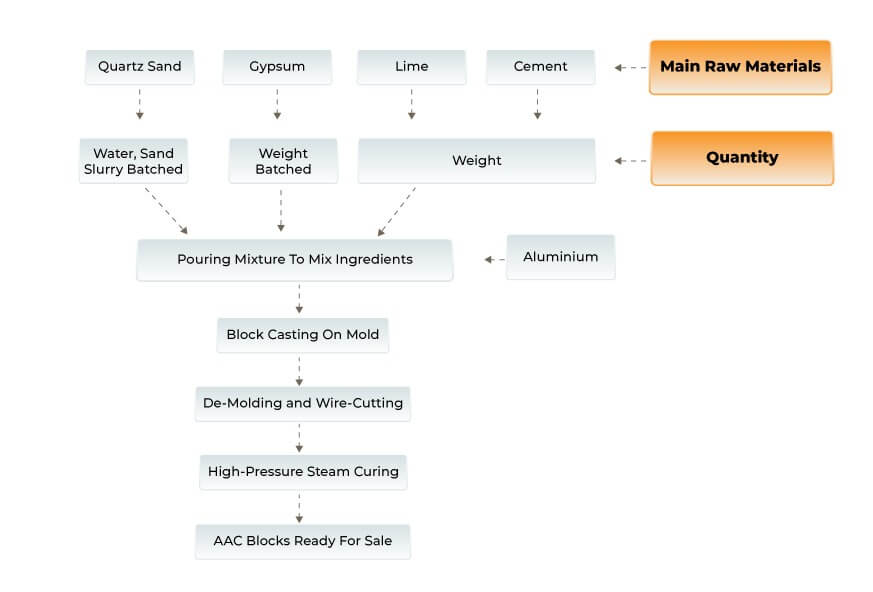AAC blocks or Autoclaved Aerated Concrete blocks, one of lightweight building material, made up of sand, calcined gypsum, lime, water, aluminium powder and cement which is heated under pressure in autoclave. These blocks are used for both interior and exterior construction. It is greyish-white in color and has thermal efficiency three times higher than clay bricks. It is 50% lighter than red bricks and also one-third of cost those bricks. Its sound insulation is approximately 42b and water absorption of about 10% of its weight. The best building material suppliers near me can help to provide good quality of AAC blocks. In order to get good-quality AAC Blocks it is important to search best AAC Blocks suppliers in you region.

While considering the utilization of AAC Blocks, firstly it is important to know the manufacturing process of AAC Blocks and also searching for manufacturers of AAC Blocks near me. In the manufacture of AAC blocks calcium hydroxide and aluminium powder is reacted in presence of water to form hydrogen. The raw materials that are used in production of AAC blocks are natural which are quicklime, cement, sand and water. In the manufacture of AAC blocks aluminium is the gas generation agent and quartz sand by quantity is the dominant material. Firstly, sand is ground in ball mills to required fineness. Alternatively, fly ash can also be used. Then ground sand in form of slurry is stored in large tanks with agitators to prevent sedimentation of sand. The gas generation agent, aluminium is dispersed in water. The mixture is poured in oiled molds where further chemical reaction takes place. The mixture expands due to reaction of aluminium and stiffens due to hydration of cement and quicklime. After filling, the mold is transported to pre-curing area which is heated to speed up the chemical reactions. As soon as procuring is finished the hardness of cake and temperature is tested. After that, the cake is tilted in upright position for cutting. During cutting and autoclaving, only cakes rest on autoclave pallets without any mold part. The block length is cut in side trimmer and then block thickness is cut. Finally, the blocks height is cut by cross cutter in which possible wires are used to facilitate high cutting accuracy. Then, the cut cake is picked up by loading machine and put in autoclave trolley. A heated waiting area in front of the autoclaves helps to avoid temperature loss of the cakes prior to autoclaving. During the steam curing the unique crystal structure is formed inside of AAC. After autoclaving, the AAC already gained its final strength. The cakes are transported to separating machine after unloading the autoclave trolleys. Here, the horizontal layers are separated which tend to be fused together during autoclaving. Finally, blocks are packed and ready for sale.
| S. No. | Length X Height X Thickness | Pcs/m3 | Wall Area /m3 |
|---|---|---|---|
| 1. | 625X 250 X 100 | 64.00 pcs | 10.00 sq.mt. |
| 2. | 625X 250 X 125 | 51.20 pcs | 8.00 sq.mt. |
| 3. | 625X 250 X 150 | 42.26 pcs | 6.66 sq.mt. |
| 4. | 625X 250 X 200 | 32.00 pcs | 5.00 sq.mt. |
| 5. | 625X 250 X 225 | 28.44 pcs | 4.44 sq.mt. |
| 6. | 625X 250 X 250 | 25.60 pcs | 4.00 sq.mt. |
| 7. | 625X 250 X 300 | 21.33 pcs | 3.33 sq.mt. |
| S. No. | Parameters | AAC Blocks | Red Bricks |
|---|---|---|---|
| 1. | WEIGHT COMPARISON | 1 AAC Block = Approx. 14.20 Kg | 8 Red Bricks = Approx. 35.02 Kg |
| 2. | IMMERSION IN WATER | Not get immersed in water because of light weight | Get Immersed in water due to its heavy weight |
| 3. | COST OF LABOUR | Labor cost of wall of 10ft x 10 ft = Rs.900 (Approx.) (Because of its larger size less manpower is required) |
Labor cost of wall of 10ft x 10 ft = Rs.2000 (Approx.) (Because of its smaller size more manpower is required) |
| 4. | JOINTS AND WORKABILTY | For 10ft x 10 ft wall 50 AAC blocks are required. So there are approximately 162 joints in that wall which leads to fast construction. | For 10ft x 10 ft wall 585 red bricks are required. So there are approximately 1656 joints in that wall which leads to slow construction. |
| 5. | COST OF MORTAR | It costs approx. Rs.650 for construction of 10ft x 10 ft wall | It costs approx. Rs.1350 for construction of 10ft x 10 ft wall |
| 6. | DRY DENSITY | Class 1 – 651-750 kg/ m3 Class 2 – 751-850 kg/ m3 Class 3 – 851-1000 kg/ m3 (Less dead load on structure) |
Class 1–1600-1720 kg/ m3 Class 2–1721-1820 kg/ m3 Class 3–1821-1920 kg/ m3 (More dead load on structure) |
| 7. | COMPRESSIVE STRENGTH | 5 N/mm2 (More strong) |
3.50 N/mm2 (Less strong) |
| 8. | WATER ABSORPTION RATIO | It should not be more than 10% of its weight | It should not be more than 20% of its weight |
| 9. | FIRE RESISTANCE | Upto 6 Hours | Upto 2 hours |